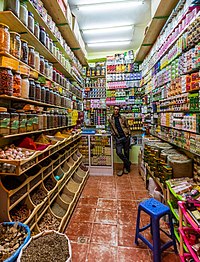
Photo from wikipedia
Abstract The COVID‐19 pandemic has had profound effects on grocery retailers, forcing them to make many operational changes in response to public health concerns and the shift in customers' shopping… Click to show full abstract
Abstract The COVID‐19 pandemic has had profound effects on grocery retailers, forcing them to make many operational changes in response to public health concerns and the shift in customers' shopping behavior. Grocery retailers need to understand the impact of pandemic conditions on their operations, but the literature has not modeled and analyzed this issue. We bridge this gap through economic models that consider the documented changes in the customers' shopping behavior during the COVID‐19 pandemic, including less frequent in‐store shopping and bulk‐shopping tendency. We capture the impact of occupancy limitation guidelines on grocery retailers' service capacity, customers' shopping behavior, and, consequently, on the retailers' store traffic and profit. We find that though store occupancy limitations reduce the in‐store foot traffic (which helps with curbing the disease spread), interestingly, they do not necessarily result in a profit decline. Under occupancy limitations and when the retailer offers the delivery or curbside pickup service, our analyses highlight the externality impact of online customers on the shopping behavior of in‐store customers. When the retailer adds the delivery service, such externalities may increase the store traffic (higher infection risk inside the grocery store) and reduce the retailer's profit. When the retailer adds the curbside pickup instead, it has more control over the impact of externalities, which helps in lowering the store traffic and increasing the profit. Our results offer valuable insights into how retailers should regard occupancy limitations and health safety measures. Our results also highlight conditions under which various operating modes may help retailers reduce infection risk and achieve higher profit.
Journal Title: Production and Operations Management
Year Published: 2022
Link to full text (if available)
Share on Social Media: Sign Up to like & get
recommendations!